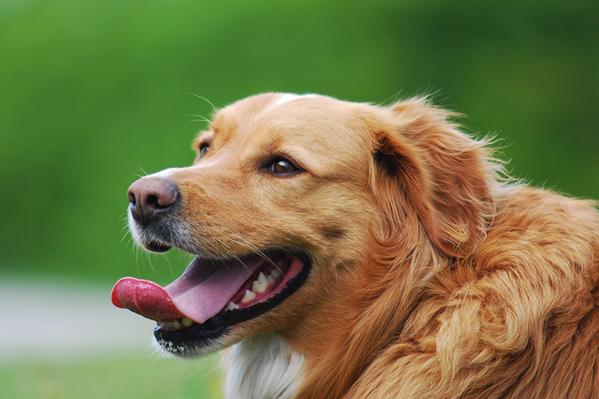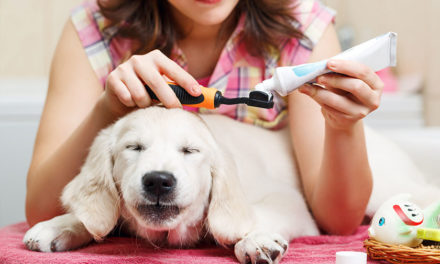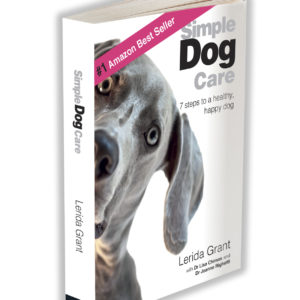Dental issues in your dog are one of the most commonly diagnosed problem in dogs over three. And if not treated, dental problems can cause a host of problems, from weakening his immune system to damaging vital organs like the kidneys or heart.
Here’s our step-by-step guide to keeping doggy dental dramas at bay
The top three offenders are:
- Plaque – bacteria living on the remnants of food in the mouth join forces with saliva and food debris in the channel between the tooth and gums causes plaque. It typically collects on the outside of teeth, especially the upper pre-molars and molars.
- Tartar – also known as calculus, it occurs when plaque combines with minerals in the saliva and hardens. This can lead to gingivitis, a reddening of gums close to the tooth (and could be why your best buddy has breath you could strip paint with!).
- Periodontal disease – If tartar is allowed to build up under the gum line, eventually it will separate the bony structures of the jaw from the teeth to form pockets and abscesses that encourage even more bacterial growth. When that happens, damage is irreversible and tooth loss, bleeding gums, eating difficulties and infections of kidneys, liver and heart are common consequences.
Signs to watch for:
- Bad breath
- Reddened, swollen or bleeding gums
- Crusted yellow-brown tartar build-up
- Drooling
- Dropping food from the mouth
- Signs that eating is painful
- Fractured, discoloured or missing teeth
- Swollen or misshapen jaw
Step by step guide to oral hygiene
You wouldn’t go too many days without a good oral clean, and your dog’s teeth and gums deserve the same treatment – at least three or four times a week and ideally every day. Start when he’s a pup (even before he loses his puppy teeth by four to six months) and you’ll be instilling a good routine without much fuss.
- Step 1: Pick a time when your puppy or dog is calm and quiet and begin simply by lifting the lips on either side of the mouth, then gently rubbing his teeth with a finger wrapped in Chux or a washcloth. Concentrate on the outside, where plaque is most likely to build up – and praise him and give him a treat when you finish each session.
- Step 2: Once you’re both comfortable with teeth wiping, move onto a toothbrush, without toothpaste to start with. Soak the head in warm water and apply to the teeth, brushing particularly where the teeth and gums meet with the brush head at a 45º angle to reach under the gum line. Stroke up and down in even movements, without too much pressure.You can buy a brush that fits over your finger or use a soft brush from your vet or pet store.
- Step 3: Start to use an enzymatic canine toothpaste when your dog is accustomed to brushing. Never use human toothpaste. Our dog loves a liver flavoured paste bought from the vet 🙂
He won’t let me brush!
If your dog is older, chances are he won’t take kindly to brushing. If the resistance persists, you can try the following:
- Dry dog foods can also help scrape away plaque and tartar
- Dental Treats that combine treating with dental care. These are available in the We are Pets food boxes and hampers.
- Oral hygiene gels which contain enzymes to inhibit the bacteria that cause plaque – your vet should have a supply
- Dental pads that stick to the gums
- Chew toys and specially formulated dental chew products designed to reduce tartar and massage the gums
At the vet
Your annual check-up is a good time to make sure all’s well with your dog’s teeth and gums. During the exam, your vet will check for any swelling, asymmetry or discharge, check inside the mouth at the teeth, tongue, gums and also take a look at the palate and tonsils. If there’s any tartar build-up, it should be removed.
What to Do:
You’ll need a good canine toothbrush and paste, and a bit of patience. If you’re still unsure how to tackle your dog’s teeth, ask your vet for advice.
You can also use dental treats to combine treating with dental care.
In Summary:
- Teeth and gum health play a major role in a dog’s general well being
- Signs of problems include bad breath, trouble eating, drooling or swelling in the jaw or face area
- Start cleaning his teeth when your dog is a puppy
- Make sure your vet does a dental examination at every check-up
Dr Lisa Chimes’ Vet tips
Cleaning your dog’s teeth as much as you clean your own may help prevent serious illness.
If your dog refuses the brush the Vet can clean your dogs teeth.
Products such as dental treats can help alleviate the need for this.
written with help from Dr. Lisa Chimes.





I’ve had dogs all my life and I never realised how important their dental hygiene is until reading this post! Thank you so much – I’ll be adding these tips to Sam’s (our dog) routine and speaking to our vet at our next appointment
Oral hygiene for pet animals like dogs is as important as for human beings.pet owner must take oral care of their pets by proper brushing of their teeth,applying gel if required to avoid tooth decay.they may consult local vet for assistance